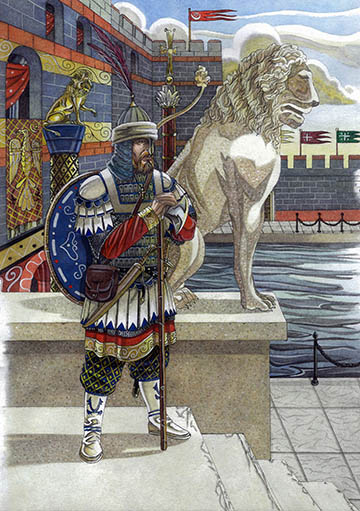 This Varangian Guard is standing outside the Boukoleon Palace, which was decorated with statues of lions and bulls. You can see banners on the right.
This Varangian Guard is standing outside the Boukoleon Palace, which was decorated with statues of lions and bulls. You can see banners on the right.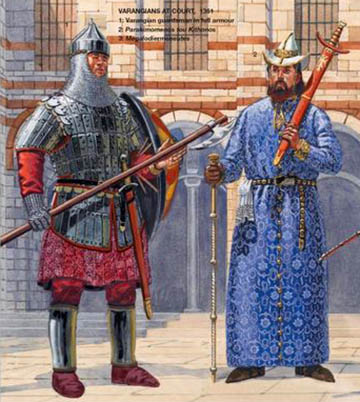 Here we see a guard and court official standing in the courtyard of the Blachernae Palace. He might not be a Varangian because he is not carrying an axe. That strange white hat was actually worn in late Byzantine times. Byzantine peaked hats were widely admired abroad.
Here we see a guard and court official standing in the courtyard of the Blachernae Palace. He might not be a Varangian because he is not carrying an axe. That strange white hat was actually worn in late Byzantine times. Byzantine peaked hats were widely admired abroad.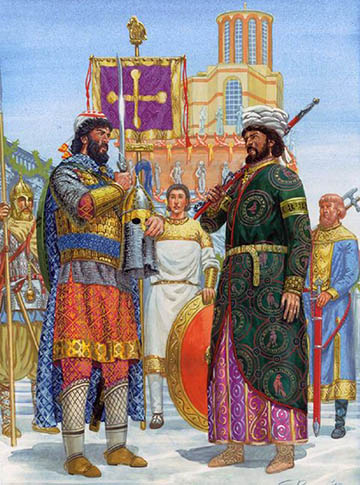 The Chalke Gate of the Great Palace had a high dome over it like this one.
The Chalke Gate of the Great Palace had a high dome over it like this one.

Building Works of Manuel I Komnenus Around Constantinople
From O City of Byzantium by Niketas Choniates
A work of this emperor was the tower standing not far from the sea whose waves washed the dry land called Damalis; another tower was built on the opposite side of the straits right next to the Monastery of Mangana. The emperor constructed these towers in order to block the occasional attacks by barbarian ships by stretching an iron chain from one shore to the other, thus rendering impenetrable both the regions in the vicinity of the City's acropolis and the channel whose waters coursed all the way to the palace complex in Blachernai.
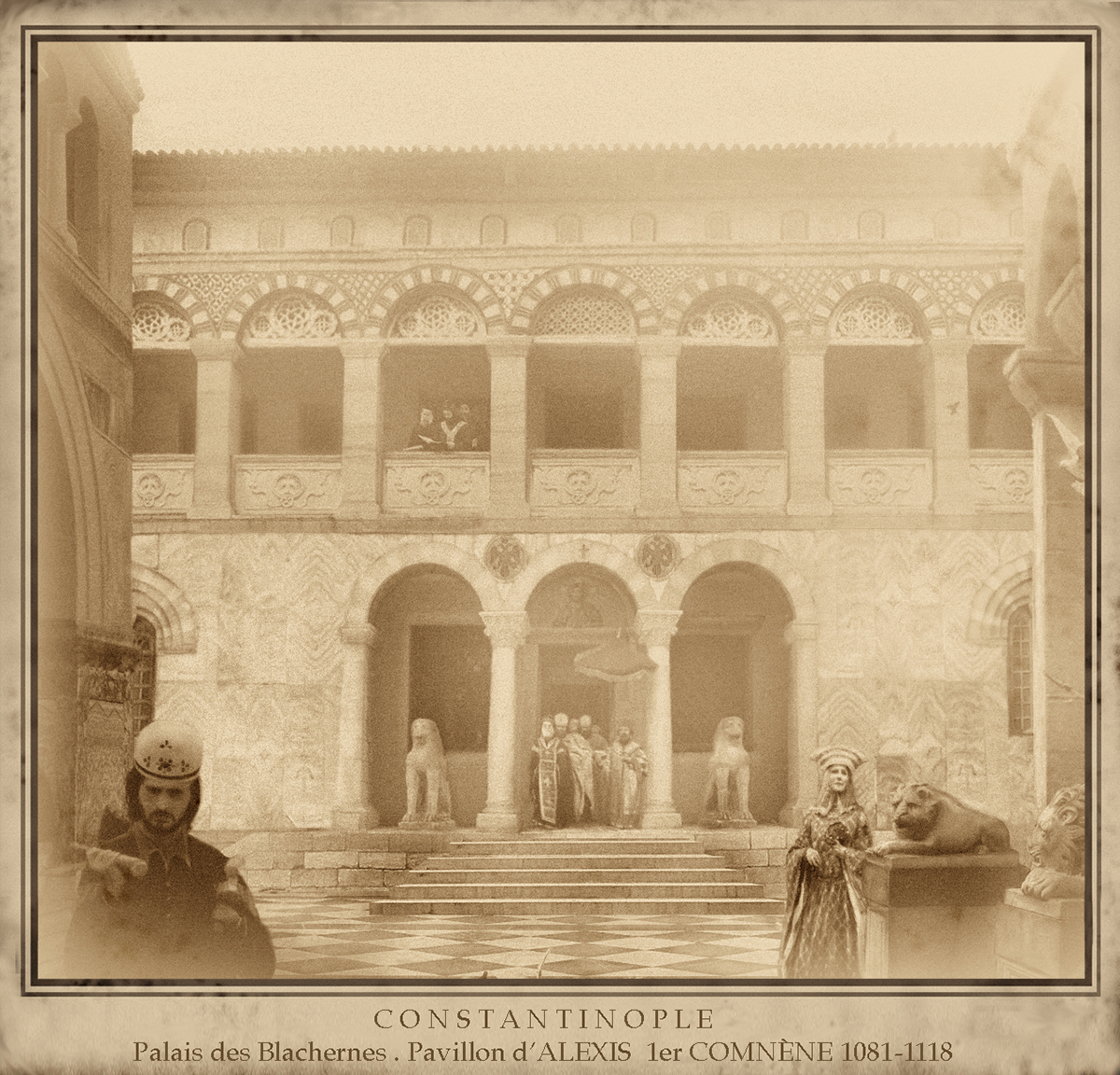 The emperor was criticized for his passion for erecting beautiful structures, for having built the very long peristyle galleries at both palaces which shimmered with gold mosaics that depicted in the variegated colors of flowers and in the wondrous craft of the artists his feats against the barbarians as well as whatever other benefits he had provided for the Romans. He also erected most of the splendid edifices along the strait of the Propontis wherein the Roman emperors spend the summer in relaxa- tion; just as the rulers of Persia in ancient times had built Susa and Ecbatana, so did he raise these, but in adornment they far surpassed the former."'
The emperor was criticized for his passion for erecting beautiful structures, for having built the very long peristyle galleries at both palaces which shimmered with gold mosaics that depicted in the variegated colors of flowers and in the wondrous craft of the artists his feats against the barbarians as well as whatever other benefits he had provided for the Romans. He also erected most of the splendid edifices along the strait of the Propontis wherein the Roman emperors spend the summer in relaxa- tion; just as the rulers of Persia in ancient times had built Susa and Ecbatana, so did he raise these, but in adornment they far surpassed the former."'
He withstood the toils of war exceedingly well, enduring the hardships which the times demanded of him; he suffered the cold, abided the stifling heat, and resisted sleep; but when he was not campaigning he indulged himself in luxuries and took pleasure in recreation. If one carefully observed how much he relished savory dishes and enjoyed the playing of the small lyre and cithara with harmonious singing, one would have said that he had grown up only in such amusements and that pleasure was the primary purpose of life; if on the other hand, one considered how, in difficult times, he set aside his readiness to indulge in every kind of trivial luxury, one marveled how he moved back and forth between the two.
Undertaking to rebuild the enormous and most beautiful church of Hagia Eirene [Holy Peace], situated near the sea and which had been erected long ago by the excellent Marcian [450-57] and was laid waste by fire, he restored a portion of this temple from the foundations but did not complete the work.
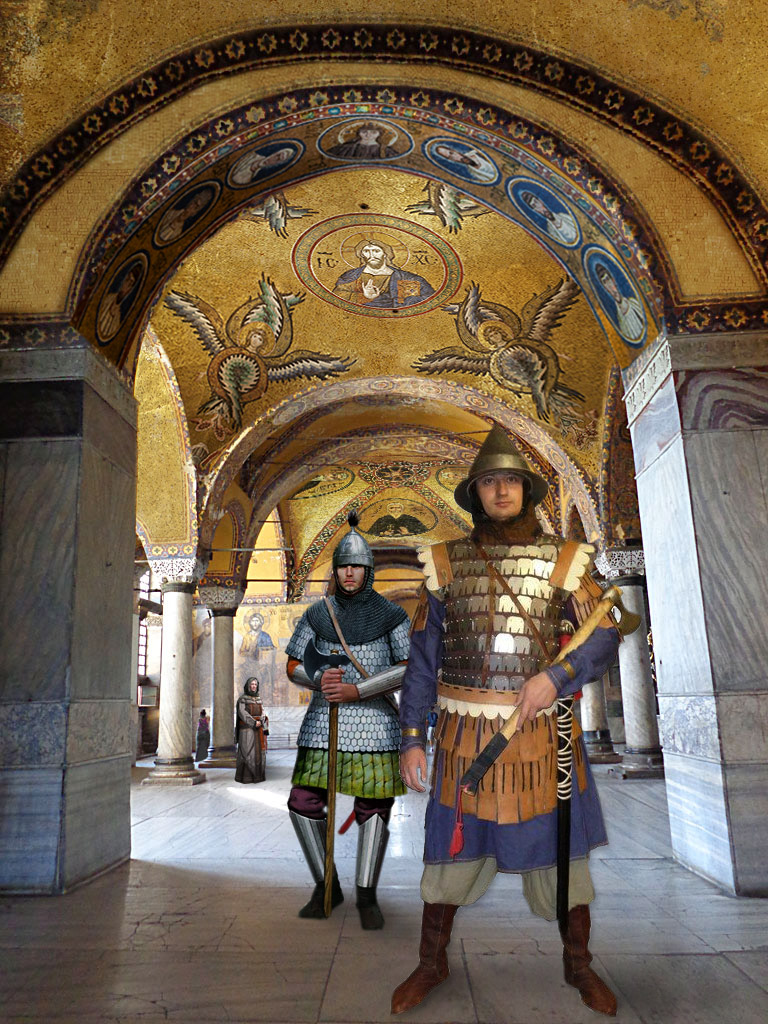 He founded a holy monastery near the mouth of the Pontos at a place called Kataskepe [Covering], named for the Archangel Michael and, gathering together the most celebrated and renowned monks of the time, he provided for them to lead an altogether solitary and untroubled life. Recognizing that ownership of landed estates as well as being troubled about many things diverted from tranquility those who had chosen the solitary life and led them away from the life in God which was their special calling, he did not set apart for them any small property or assign fields and vineyards to the monastery. By paying for the monks' necessities from the imperial treasuries, he thus restrained, I believe, the excessive desire of most to build monasteries. He also provided an example for those who followed that whenever there was a need to set up church buildings, it was also necessary to provide board for the solitaries who had no means of subsistence and had set themselves free of material concerns.
He founded a holy monastery near the mouth of the Pontos at a place called Kataskepe [Covering], named for the Archangel Michael and, gathering together the most celebrated and renowned monks of the time, he provided for them to lead an altogether solitary and untroubled life. Recognizing that ownership of landed estates as well as being troubled about many things diverted from tranquility those who had chosen the solitary life and led them away from the life in God which was their special calling, he did not set apart for them any small property or assign fields and vineyards to the monastery. By paying for the monks' necessities from the imperial treasuries, he thus restrained, I believe, the excessive desire of most to build monasteries. He also provided an example for those who followed that whenever there was a need to set up church buildings, it was also necessary to provide board for the solitaries who had no means of subsistence and had set themselves free of material concerns.
He so disapproved of the present situation where those who profess to be monks are richer in substance and more careworn than those who are fond of wordly pleasures that he revived the novella of that most excellent emperor of heroic prowess and great wisdom, Nikephoros Phokas, which prohibited the monasteries from increasing their properties but which eventually had become a dead letter and lost its authority, by appending his signature in red ink that, like blood, warms again and quickens with life.
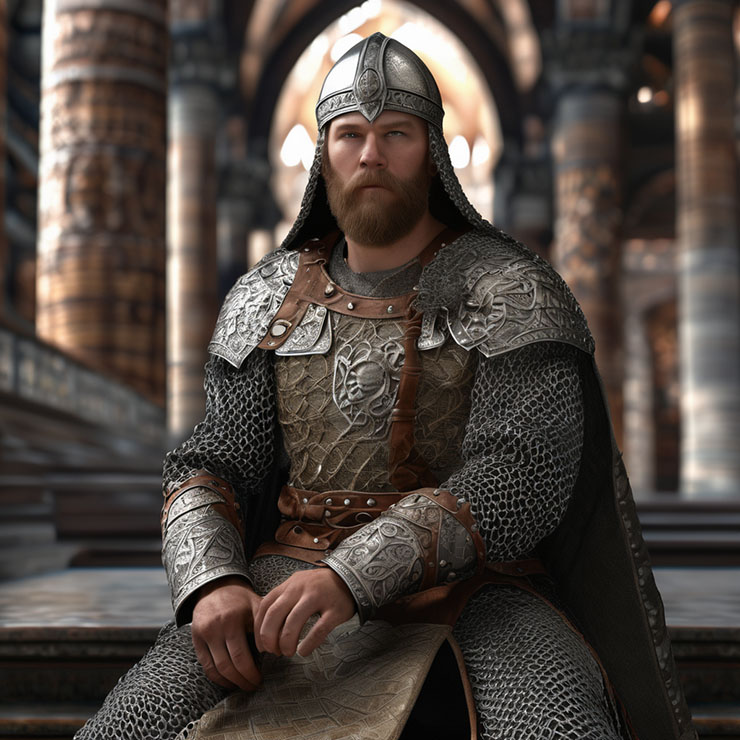 Nor did he desist from blaming his father and grandfather and all his remaining kinsmen who had founded monasteries and assigned to them fruitful parcels of land and verdant meadows; he cast blame or heaped ridicule upon these men, not because they had granted a portion of their possessions to God, but because they had not performed their good works in the best way. For it was fitting that monks should set up their habitation in out-of-the-way places and desolate areas, in hollow caves and on mountain tops, and that they avoid this fair City situated on the Hellespont even as Odysseus avoided the lotus and the irresistible Sirens' songs. But some monks sought the praise of men and set up their whited sepulchers in full view of those entering the churches, and, even when dead, they desired to depict themselves as crowned in victory and with cheerful and bright countenances. They built their holy monasteries in the marketplace and at the crossroads and confined themselves to these as though in caves, not choosing the path of moral virtue as characterizing the monk but rather the tonsure, the habit, and the beard. Because of these things, either in an attempt to uphold monastic dignity, which had fallen flat and was fast disappearing, or in fear lest he be caught doing what he had condemned, the emperor took a course different from that of his kinsmen.
Nor did he desist from blaming his father and grandfather and all his remaining kinsmen who had founded monasteries and assigned to them fruitful parcels of land and verdant meadows; he cast blame or heaped ridicule upon these men, not because they had granted a portion of their possessions to God, but because they had not performed their good works in the best way. For it was fitting that monks should set up their habitation in out-of-the-way places and desolate areas, in hollow caves and on mountain tops, and that they avoid this fair City situated on the Hellespont even as Odysseus avoided the lotus and the irresistible Sirens' songs. But some monks sought the praise of men and set up their whited sepulchers in full view of those entering the churches, and, even when dead, they desired to depict themselves as crowned in victory and with cheerful and bright countenances. They built their holy monasteries in the marketplace and at the crossroads and confined themselves to these as though in caves, not choosing the path of moral virtue as characterizing the monk but rather the tonsure, the habit, and the beard. Because of these things, either in an attempt to uphold monastic dignity, which had fallen flat and was fast disappearing, or in fear lest he be caught doing what he had condemned, the emperor took a course different from that of his kinsmen.




 click here for icons of christ
click here for icons of christ click here for icons of the theotokos
click here for icons of the theotokos click here for icons of angels
click here for icons of angels click here for icons of saints
click here for icons of saints








